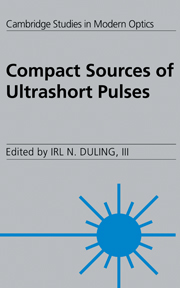Book contents
- Frontmatter
- Contents
- List of contributors
- Acronyms and abbreviations
- Preface
- 1 Short pulse generation
- 2 Passive modelocking in solid state lasers
- 3 Compact modelocked solid state lasers pumped by laser diodes
- 4 Modelocking of all-fiber lasers
- 5 Nonlinear polarization evolution in passively modelocked fiber lasers
- 6 Ultrafast vertical cavity semiconductor lasers
- 7 High power ultrafast semiconductor injection diode lasers
- 8 The hybrid soliton pulse source
- 9 Monolithic colliding pulse modelocked diode lasers
- Index
Preface
Published online by Cambridge University Press: 20 January 2010
- Frontmatter
- Contents
- List of contributors
- Acronyms and abbreviations
- Preface
- 1 Short pulse generation
- 2 Passive modelocking in solid state lasers
- 3 Compact modelocked solid state lasers pumped by laser diodes
- 4 Modelocking of all-fiber lasers
- 5 Nonlinear polarization evolution in passively modelocked fiber lasers
- 6 Ultrafast vertical cavity semiconductor lasers
- 7 High power ultrafast semiconductor injection diode lasers
- 8 The hybrid soliton pulse source
- 9 Monolithic colliding pulse modelocked diode lasers
- Index
Summary
Since the development of the first diode lasers and the recent proliferation of fiber amplifiers, the dream of researchers for a compact, efficient, turn-key source of ultrashort pulses has come closer to reality. A number of candidates for this ultimate source have been proposed and researched and a large body of information has been produced. To date there has not been a compilation of this valuable information in one place. It is the intent of this work to present the state of the art in the development of these sources. It is the added intention to provide a basis for the future research of others attempting to enter this still very active field.
In 1983, when the technique of electro-optic sampling was developed, the dream was that the sampler could be combined with a compact ultrashort pulse source to produce a subpicosecond resolution oscilloscope. This technology has languished due to the missing source. In 1988 the development of high efficiency low temperature GaAs photoconductive switches has produced similar high promise, but there is still no suitable low cost compact ultrashort pulse source. It is hoped that this book will show that much progress has been made since the early 80s and the groundwork has been laid for a new class of instrumentation, where a laser is included for optical processing and may not ever leave the instrument.
- Type
- Chapter
- Information
- Compact Sources of Ultrashort Pulses , pp. xv - xviiiPublisher: Cambridge University PressPrint publication year: 1995



